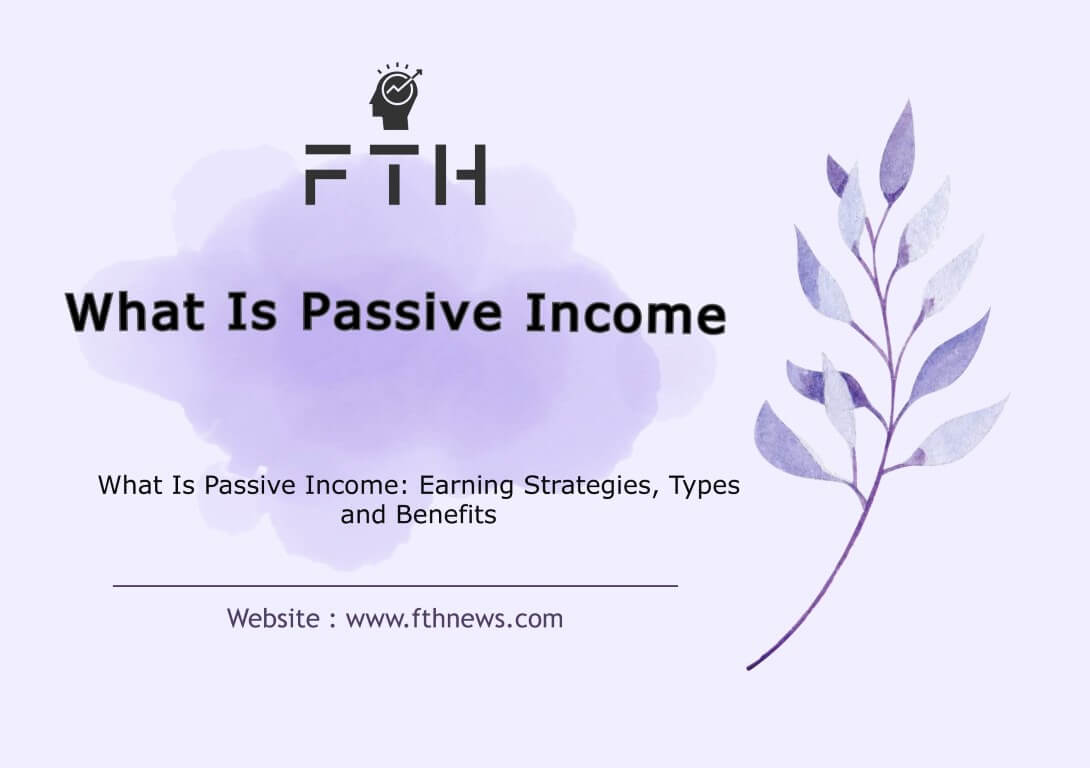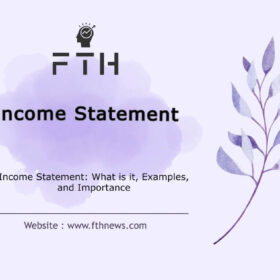
What Is Passive Income: Earning Strategies, Types, and Benefits
In the dynamic landscape of finance and entrepreneurship, the concept of passive income has evolved into a captivating buzzword, enticing individuals with the promise of “earning money even while sleeping.” As the pursuit of financial independence gains momentum, understanding the nuances of passive income becomes paramount. This article embarks on a journey to demystify passive income, unraveling its essence, distinguishing it from active income, and presenting diverse methods to cultivate this transformative financial stream.
What is Passive Income?
Passive income, in its essence, is a financial stream earned with minimal active involvement, a departure from the conventional model of exchanging time for money.
This form of revenue allows individuals to accrue earnings through avenues that require prior effort, often described as “earning money while sleeping.” As we delve deeper into the realm of passive income, we’ll explore its intricacies, shed light on the distinctions between active and passive income, and unveil a myriad of methods to harness its potential.
Active vs. Passive Income: Unraveling the Core Differences
In the intricate tapestry of income generation, a fundamental dichotomy emerges between active and passive income. Understanding this contrast is pivotal for anyone seeking financial empowerment.
Active Income: The Fruits of Direct Effort
Active income is the fruit of direct effort or output, often synonymous with the conventional realms of employment. This type of income thrives on the correlation between the time and energy invested and the financial returns garnered. In the realm of active income, one is compensated for the immediate value contributed through labor, services, or skills.
Passive Income: Nurtured by Prior Work and Capital
In stark contrast, passive income emerges as a more elusive and intriguing counterpart. It is not contingent on direct, ongoing effort but rather blossoms from the seeds of prior work and the judicious utilization of accumulated knowledge or capital. income embodies the concept of “earning money while you sleep,” representing a departure from the traditional model of exchanging time for monetary rewards.
In essence, the distinction lies not only in the method of earning but also in the temporal relationship between effort and financial gain. While active income necessitates continuous engagement, passive income allows individuals to transcend the immediate exchange of time for money, creating a pathway to financial freedom and flexibility.
How to Start Creating Passive Income
Embarking on the path to cultivate passive income requires not just enthusiasm but a strategic approach. Let’s navigate through a step-by-step guide to set you on the right course:
1. Identify Your Interest Area: Nurturing Passion into Profit
The initial step involves identifying a sector that aligns with your interests and expertise. Choosing an area you’re passionate about not only fuels motivation but also enhances your likelihood of success. Delve into your skills, hobbies, and knowledge to pinpoint the foundation of your passive income ventures.
2. Research and Planning: Illuminating the Path Ahead
Once your interest area is defined, embark on a comprehensive journey of research and planning. Dive into the chosen sector, extracting insights from diverse sources. Gather information, analyze market trends, and understand the dynamics that will shape your venture. This groundwork forms the bedrock for informed decision-making.
Crafting Your Path to Succes
Now equipped with insights, it’s time to sculpt your passive income venture. There are two primary avenues to explore: creating a business model or investing. If you choose to create a business model, leverage your knowledge and experience to offer products or services that cater to your target audience. Alternatively, if investing resonates with your strategy, consider prudent allocation of capital to income-generating assets.
This pivotal stage demands a detailed business plan outlining your objectives, target audience, revenue streams, and scalability. Whether you embark on entrepreneurship or investment, a well-crafted plan serves as your roadmap, steering you towards sustainable passive income streams.
In essence, initiating your journey toward passive income involves a blend of passion, informed decision-making, and a well-defined roadmap. This strategic blueprint will not only set the stage for success but also lay the groundwork for a resilient and flourishing financial future.
Different Types of Passive Income
Exploring Diverse Avenues of Passive Income
In the realm of passive income, opportunities abound, each offering a unique pathway to financial autonomy. Let’s delve into the spectrum of possibilities, categorized into creating a business model and strategic investing:
A. Creating a Business Model
Online Courses: Empowering through Education
Share your expertise by offering personalized or institutional online courses. The digital era has ushered in a surge in demand for online learning, providing a lucrative avenue to impart knowledge and earn passively.
Photos: Transforming Creativity into Currency
Monetize your photography skills by selling captivating images. Whether it’s through stock photography platforms or personal ventures, turning your visual artistry into a source of income is both fulfilling and financially rewarding.
Digital Magazines and Guides: Crafting Cultural Narratives
Create digital content that encapsulates cultural insights, travel destinations, or culinary experiences. Through digital magazines or guides, you can cater to niche interests, attracting a global audience and generating passive income.
E-books: Bridging the Digital Knowledge Gap
Convert your expertise into digital books for easy consumption. E-books offer a scalable way to share valuable insights, allowing you to earn recurrent income as readers seek your knowledge on various subjects.
Graphic Design and Illustrations: Artistic Ventures in the Digital Space
Showcase your artistic talents through digital illustrations and designs. The internet is a vast canvas, and your creations can find a market for digital cards, animations, or graphic elements, providing a continuous source of passive income.
Display Advertising: Building Revenue from Web Traffic
Develop a website with significant traffic to earn from display ads. Monetizing web traffic through display advertising requires strategic content creation and audience engagement, offering a consistent stream of passive income.
Blog or Book Writing: Unleashing Creativity for Profit
Monetize a blog or website through affiliate marketing and digital products. Share your insights, experiences, or expertise through engaging content, and leverage affiliate partnerships and digital product sales to generate passive income.
B. Investing
Interest Income: Growing Wealth Passively
Accumulate savings and let them grow through interest over time. Interest income from savings accounts, CDs, or other interest-bearing instruments provides a low-risk avenue for passive wealth accumulation.
Rental Income from Real Estate: Realizing Property Returns
Invest in real estate and earn consistent rental payments. Real estate, a classic avenue for passive income, involves purchasing property and leasing it to tenants, providing a stable and ongoing source of revenue.
Gold or Lease Certificates: Precious Returns on Investment
Invest in gold-backed lease certificates for annual interest income. This strategy allows you to benefit from gold’s stability while earning passive income through lease agreements.
Private Equity: Direct Investment in Growth
Invest directly in companies, contributing to venture capital. While potentially riskier, private equity investments offer the opportunity for substantial returns, especially for those willing to engage in long-term commitments.
Stock Exchange: Harvesting Dividends from Investments
Invest in dividend-producing assets such as stocks, REITs, and index funds. Participating in the stock market allows you to capitalize on companies’ profits, earning dividends and potentially benefiting from stock appreciation.
Peer-to-Peer Lending (P2P): Direct Financial Connections
Connect lenders and borrowers directly, earning interest on loans. In the evolving landscape of finance, P2P lending platforms facilitate direct financial interactions, allowing you to earn interest as you provide capital to borrowers.
Navigating this diverse landscape, individuals can tailor their passive income strategy to align with their skills, interests, and risk tolerance, fostering a sustainable and diversified financial portfolio.
Advantages of Passive Income
Unlocking the potential of passive income introduces a myriad of advantages that extend beyond financial prosperity. Let’s delve into the transformative benefits that come with cultivating passive income:
1. Additional Cash Flow: Elevating Financial Fortunes
Passive income serves as a dynamic catalyst, injecting additional cash flow into your financial ecosystem. Beyond traditional income sources, this supplementary wealth has the potential to not only boost your overall financial standing but also lay the foundation for early retirement or a nomadic lifestyle, where work is a choice, not a necessity.
2. Financial Freedom: Liberation from Traditional Constraints
The true power of passive income lies in its capacity to liberate individuals from the shackles of traditional employment. By seamlessly covering living expenses, passive income affords the luxury of financial freedom. No longer bound to a conventional job, individuals can chart their financial destiny on their terms.
3. Stress Reduction: Alleviating Financial Worries
Insufficient funds often stand as a significant stressor in individuals’ lives. Passive income acts as a formidable ally in alleviating these financial worries. As a reliable and recurring stream, it minimizes concerns about meeting day-to-day expenses, contributing to a significant reduction in overall stress and anxiety.
4. Location Independence: Flexibility Beyond Boundaries
One of the most alluring advantages of passive income is the liberation it provides in terms of location independence. No longer tethered to a specific place of work, individuals can embrace a lifestyle marked by unparalleled flexibility. Whether working from the comfort of home or exploring new horizons as a digital nomad, passive income affords the freedom to choose your workplace.
In essence, passive income transcends the conventional financial narrative, offering not just monetary gains but a holistic transformation of lifestyle and well-being. By tapping into the power of passive income, individuals can craft a future where financial abundance meets the freedom to live life on their own terms.
Unlocking the Varied Potential of Passive Income Earnings
The potential earnings from passive income constitute a dynamic spectrum influenced by factors such as scalability, demand, and the dedicated effort invested in creating income-generating products. In this realm, there exists no fixed limit, and the rewards span from meeting daily needs to crafting a robust retirement plan.
Diverse Avenues, Diverse Earnings: A Tapestry of Opportunities
The beauty of passive income lies in its adaptability to diverse financial goals. Whether you envision it as a supplementary source to cover daily expenses or a cornerstone in a comprehensive retirement strategy, the potential is vast. Earnings hinge on the ingenuity of your chosen avenues, be it online courses, stock investments, or real estate ventures.
Understanding the Boundless Horizon: No Fixed Limit
In the landscape of passive income, the horizons are boundless. The potential earnings are not confined by traditional salary caps or hourly rates. Instead, they reflect the scalability of your endeavors, the demand for your products or services, and the strategic effort invested in creating a sustainable income stream.
Crafting Financial Freedom: Beyond Monetary Gains
In conclusion, delving into the realm of passive income unfolds a journey toward financial freedom, stress reduction, and the empowerment to design a lifestyle that harmonizes with personal aspirations. While the journey may commence with initial challenges, the transformative rewards are well worth the effort.
Tax Treatment of Passive Income
When it comes to the tax treatment of passive income, it’s essential to understand the nuances that distinguish it from other types of income. Passive income is generally earned from activities in which the taxpayer is not materially involved, such as rental income, dividends, and interest from investments.
Here are key points regarding the tax treatment of passive income:
Tax Rates: Passive income may be subject to different tax rates compared to earned income. The tax rates can vary based on the type of passive income and the taxpayer’s overall income bracket.
Material Participation: The IRS defines material participation to determine whether an individual is actively involved in an income-generating activity. Passive activities may have limitations on deducting losses, and the level of involvement can impact the tax treatment.
Passive Losses: Passive losses are losses incurred from passive activities. These losses may be limited in terms of how much can be deducted in a given tax year. Unused losses can often be carried forward to offset future passive income.
Passive Income Examples: Common examples of income include rental income, dividends from stocks, interest from certain investments, and profits from businesses in which the taxpayer is not materially involved.
Tax Deductions: Expenses related to passive activities are generally deductible against income. This includes expenses for managing rental properties or costs associated with generating income.
Passive Income and Social Security: income can impact Social Security benefits. If income, along with other earnings, exceeds certain thresholds, a portion of Social Security benefits may become taxable.
Tax Planning: Effective tax planning is crucial for optimizing the tax treatment of income. This may involve structuring investments, managing deductions, and considering the overall tax implications of various income streams.
It’s advisable to consult with a tax professional or financial advisor to navigate the complexities of passive income taxation. Understanding the specific rules and regulations applicable to your situation can help optimize your tax position and ensure compliance with tax laws.
Conclusion:
- Diverse Possibilities: Passive income encompasses a plethora of possibilities, ranging from interest on savings to rental income and investments in stocks and real estate.
- Tax Implications: Considerations such as “material participation” play a crucial role in managing passive income, emphasizing the importance of understanding the tax landscape associated with different income streams.
- Balanced Financial Strategy: Individuals can strategically claim passive losses against income generated from passive activities, emphasizing the significance of a well-balanced and informed financial strategy.
In essence, passive income is not merely a financial pursuit; it is a strategic and transformative approach to crafting a future where financial abundance aligns harmoniously with personal aspirations.
FAQ
Passive income is money earned with minimal effort or direct involvement. An example is earning rental income from real estate.
Achieve $1000/month through methods like investing in dividend stocks, creating and selling an online course, or earning from affiliate marketing.
Generate passive income by investing wisely, creating digital products, or engaging in ventures that generate money without constant active involvement.
Yes, it’s possible to live off passive income, especially with strategic investments, real estate, or creating scalable online businesses.
High-yield savings accounts or dividend stocks are considered easier forms of passive income with minimal active management.
Yes, passive income is generally taxable. The tax rate may vary depending on the source and local tax laws.
The IRS treats passive income differently, often subjecting it to specific rules, including “material participation” criteria.
Yes, rental income is generally considered passive income, subject to specific tax rules.
Passive income can affect Social Security benefits based on your overall income. Exceeding certain thresholds may lead to taxation of benefits.














